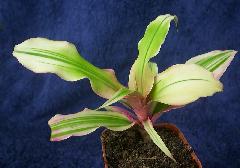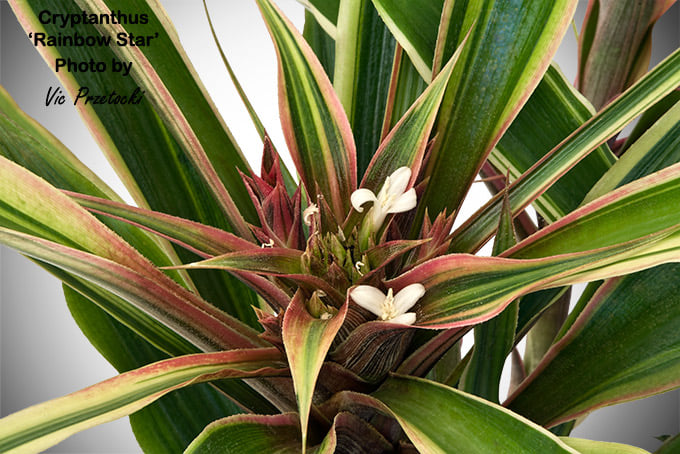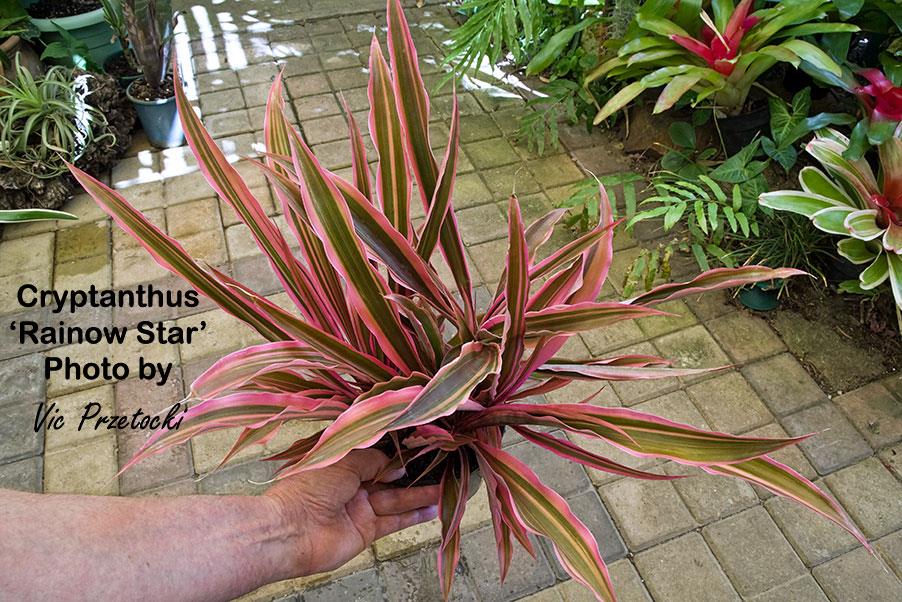Cryptanthus Rainbow Star
Click thumbnails for full size, scaled to a new window.
Cryptanthus Rainbow Star
From BCR: < 1991. Possibly a sport of osiris (See 'Wendy Variegata' & 'Seaborn's Leather Leaf')
CC 1991, J Brom. Soc. 51(1): 7. 2001


| Ian Hook, Sydney 05/05. Originally as bromelioides v. tricolor, then as C. Tricolor, is most likely a form of Cryptanthus osiris |



| Vic Przetocki 02/22 |
Vic Przetocki 11/23 |
CULTIVAR CORNER
Cryptanthus 'Rainbow Star' by Derek Butcher.
In the Oct/Dec 2000 issue of the Cryptanthus Society Journal, page 78, Harry Luther pointed out that the plant we have been growing for many years as Cryptanthus bromelioides is in all probability Cryptanthus osiris Weber. The true Cryptanthus bromelioides has been re-discovered in Brazil by Ivon Ramirez.
This leads me to that widespread variegated plant called Cryptanthus bromelioides var. tricolor which Harry left in limbo in his article. This plant should never have been given botanical varietal status because it is a Sport which brings it into the realm of the cultivar.
If we refer to the Bromeliad Cultivar Registry (1998) we will see this plant goes under at least three disguises, namely 'Rainbow Star', 'Wendy Variegata', and 'Seaborn's Leather Leaf'. As luck would have it, this plant is known in the general plant trade as the "Rainbow Bromeliad"; therefore, I believe the best name to use is 'Rainbow Star'.
It is a very unstable variegate with almost every offset different to the parent plant, so each could be considered a separate Sport! What will never be proved is whether the other allied cultivar names in the BCR occurred by sporting from a, now, Cryptanthus osiris in exactly the same way that Foster reported his Cryptanthus bromelioides var. tricolor in 1953. Was there more than one clone of the non-variegated form in circulation, or were all of them offsets from the same plant? Were all sporting variegated offsets selected for vigour or were runts allowed to grow on too? An intriguing situation!
In the same way that it has been accepted that Cryptanthus bromelioides var. tricolor could vary I will be treating all Sports of this kind under the same name 'Rainbow Star' and will make note in the Bromeliad Cultivar Registry accordingly.
"Cryptanthus 'Rainbow Star' De-mystified" by Nina Rehak Feb 2002
Formerly known as C. bromelioides var. tricolor, 'Rainbow Star' is now considered as possibly a sport of C. osiris, an oddity in the genus. Most Cryptanthus have a single rosette which matures, flowers then stops growing, directing its energy towards seeding and pupping. By comparison, 'Rainbow Star' produces one or more basal pups while still juvenile, as the parent continues growing.
Culture is similar for most Cryptanthus: good, filtered light for foliage colour; warmth and humidity for continuous growth. The terrestrial growing medium should be light, humus-rich and free-draining with fertiliser added. The mix should never dry out and high humidity can be maintained by standing the pot in a tray with wet peat-moss. Depending on climatic conditions and if dormant, watering and feeding should be adjusted accordingly.
I grow two distinct forms which are both natural clumpers akin to a small shrub and cannot be grown as a single rosette. Basal offshoots are not pups but immature stems and must not be removed from the parent.
Do not remove pups as they develop for they will produce the next generation of offshoots--that is 'Rainbow Star's forward growth habit. There are exceptions but seldom do these offshoots appear evenly-spaced nor simultaneously from the rosette's base. Removal of the first offshoots will interrupt the natural growth cycle. A heavily variegated rosette cannot flower without support from the clump and is too weak to produce more offshoots. A single rosette will grow disproportionately tall and vegetate for a while, perhaps as a last resort producing a leaf axil pup. It has reached the stage where complaints are heard, like "My plant just sits there, doing nothing !" It becomes obvious that constantly propagating single rosettes causes stagnant growth--every vegetative cut or division is a set-back.
My interest in C. 'Rainbow Star' began in 1977, soon after joining the BSI. Somebody told me about Mrs. Olwen Ferris in Queensland and whilst ordering some Billbergias from Olwen I asked also for 'Rainbow Star'. In the Billbergia parcel was a letter informing me "We have had a very cold Winter and all the pups died!" Several years later, during a "nursery crawl" one day, I did find my first 'Rainbow Star'. I did not know it then, but it was the perfect size to start with--about twice the height of a medium-sized Cryptanthus, with two small pups attached. All the 'Rainbow Star' Form A clone I have now are its descendants.
I have been growing and exhibiting C. 'Rainbow Star' for many years now. My two distinct forms have stayed true to their original variegation for 20 and 14 years respectively.
Form A :-Pliant, soft-textured recurving foliage; slightly-undulating leaf edges; approximately 50/50% white and mid-green variegation, the irregular creamy-white stripes flushing pink in bright, diffused light.
Form B:-Stiffer-textured, mostly albo-marginated foliage; leaves longer, more upright with pointed tips; in strong filtered light, leaf blades change to olive green with red edges; sometimes has random central fine lines.
Both my forms can be viewed on the website : http://fcbs.org/
Contrary to 'Rainbow Star's reputation, both forms do flower if left undivided. Form A needs to build up to a large clump and throughout its life will need re-potting several times. Form B will bloom as a smaller-sized clump. Only post-flowering will several pups develop slightly below an inflorescence. These pups are rather slow-growing and should not be harvested until reasonably mature. They are distinct from vigorous leaf axil pups which, unless over-crowded, I prefer to leave intact as they add fullness and enhance the clump's appearance.
Both forms are excellent subjects for the show table, from a single rosette with small offshoots to a spectacular multiple up to 40cm. tall and almost as wide. To produce large specimens takes some management which I find a creative and pleasant task. As the clump grows, some side stems may need support by staking - I prefer thin bamboo side branches. Occasionally Form A produces albino offshoots which should be pulled out whilst still small. Remove any old or damaged leaves by splitting each down the middle, teasing off the two halves in opposite directions. With reasonable care, leaf dieback or spotting are not a problem - avoid overhead watering in extremely hot or cold weather. If brown marks occur, see if removing the whole leaf is the better option rather than trimming it. You must watch the whole clump's conformation and a rosette which does not comply with the overall desired shape can be cut out (never twisted) at its base and propagated.
Cryptanthus 'Rainbow Star' is chiefly a foliage plant and although there are valid reasons to want it to flower (simply the challenge, for seed-raising or hybridising), the blooming means a partial end to a long-growing, beautiful specimen. However, by removing the oldest stems and re-potting the rest, not only will flowering be prevented but the clump will be rejuvenated.
Eventually the clump, having completed its life cycle, becomes difficult to manage, tending to fall apart. The time for real propagation has arrived. Carefully peel off the older rosette stem's capillary leaves. Adventitious stem roots should be visible, perhaps for 1cm. at the base but hardly discernible higher up. Leave foliage intact at the top for 10- 12cms. Plant the rosette stem as deep as possible to maximise rooting, but not burying the lower leaves. (If not planting immediately, stand the stem in water with a drop of fertilizer added. This prevents drying out and encourages rooting). As rooting occurs, basal offshoots emerge which, if the parent is too tall to begin with, will never "catch up" to achieve a balanced multiple. The developing pups, at various growth stages, begin filling the pot.
In the short term, but only if absolutely necessary, no harm will come by dividing the young clump in two or by removing the oldest stem with roots intact, planting it as it is, unless too tall. 'Rainbow Star' has a very fine root system which should be disturbed as little as possible.
For the long-term benefit, propagating by old stems is preferable to preserve the clone's vitality. An old stem has fulfilled its first duty by producing pups and its remaining purpose is to flower. Therefore removing the old stem, which is still capable of further pupping, does no harm to an already-established young clump. By this method of vegetative reproduction, the previously-weak clone is strengthened.
C. 'Rainbow Star' has been accused of having unstable variegation with every pup differently-striped, which is partly true. However, stability of variegation is judged by a plant's ability to transmit variegation to its progeny, not by the pattern of variegation, in my opinion. Both my forms I describe as "consistently inconsistent" which have never produced totally-green pups while in my care, surely a record among variegated bromeliads. Variegation is a bonus enjoyed and sometimes artificially induced by humans but it is a genetic defect. Sometimes the plant succeeds in "curing" itself by reverting back to all-green leaves.
C. 'Rainbow Star' is hardier here than its appearance suggests. I live in Sydney, not far from the Pacific coast. The sub-tropical climate is usually mild and humid with frequent temperature changes in Spring and early Summer. During Summer's humid heat my 'Rainbow Star's are hung outside among other bromeliads in the fresh air under 50% shadecloth. When Autumn temperatures begin dropping below 10 degrees Celsius, my 'Rainbow Star's are returned to the heated, double-glazed glasshouse. If cold winter nights drop below 5 degrees Celsius, an electric oil heater raises it to 10 degrees, but mainly because of other tropicals housed there. Cryptanthus 'Rainbow Star' is easier to grow and flower here than many other bromeliads---all it needs is some understanding.
Acknowledgement: Many thanks to Geoff Lawn for assisting with this article.
Updated 09/11/23




